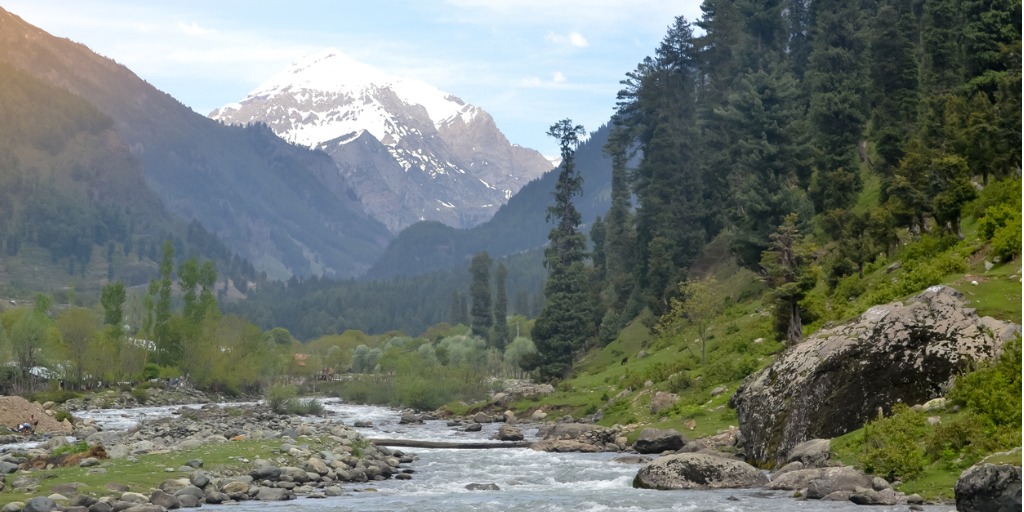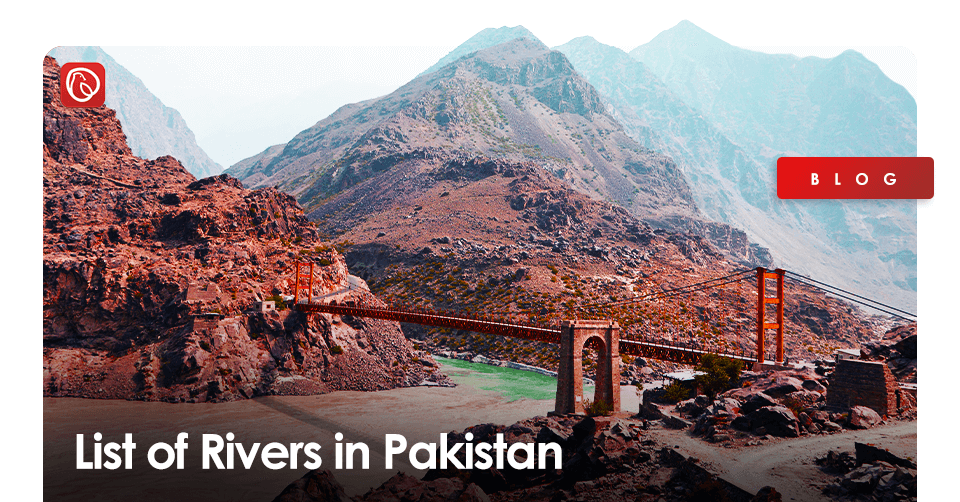The deep yet calm rivers in Pakistan are pleasant to watch. The soothing waves and serenity can make anyone peaceful and calm in a jiffy. Apart from the tranquility and beauty, the rivers are also of great economic and political importance.
Rivers are not only the primary source of drinking water but they are also used in irrigation and hydropower generation. Hence, for the establishment of any stable economy, the presence of rivers is crucial.
Pakistan is a country that has beautiful scenic views, historic buildings, most horror places, and an abundance of natural resources. There are majestic mountains, wonderful coastal beauty, and lush green plains and meadows.
It has an advanced education system and the best healthcare facilities. Pakistan is blessed with several rivers. To know more about the major rivers of Pakistan, keep on reading.
Importance of Rivers in Pakistan
Rivers play a key function in shaping the geography, economy and overall betterment of Pakistan. Here are some key aspects highlighting the importance of rivers in Pakistan:
Agriculture and Irrigation
Pakistan’s predominant rivers, including the Indus, Jhelum, Chenab, and Ravi, contribute significantly to agriculture through irrigation. The vast canal system, derived from these rivers, supports the cultivation of crops, making agriculture possible.
Water supply
Rivers are the number one freshwater supply in Pakistan for every agricultural and domestic use. They provide water for consumption, business strategies and various daily needs, thereby supporting the maintenance of a growing population and various economic activities
Hydropower production
Pakistan is based on hydropower for a huge part of its electrical technology. River navigation is used through dams and dams to generate hydropower. Dams like Tarbela and Mangla are critical for electricity generation and water garages, contributing to the security of the United States of America fort.
Biodiversity and Ecosystems
River ecosystems support diverse flora and fauna. They provide habitat for many species of fish, birds and other wildlife. The health of river ecosystems is important for the preservation of biodiversity and the preservation of the natural environment.
Flood Control
Although rivers bring water for agriculture, they can also pose a danger in the form of floods, especially during the monsoon season. Proper management of rivers together with the construction of dams helps to mitigate the consequences of floods and shield communities.
How Many Rivers in Pakistan?
There are five rivers in Pakistan:
| Pakistan Rivers Names | Length | Source | Bridges | Nearby Cities |
| 1. River Jhelum | 725 km | Pir Panjal Range | Kohala Bridge, Zero Bridge, Jhelum Bridge, Abdullah Bridge | New Mirpur City, Muzaffarabad, Jhang, Srinagar, Baramulla, Anantnag, Sopore, Pampore, Awantipora |
| 2. River Chenab | 960 km | Baralacha La Pass | Chenab Rail Bridge, Old Chund Bridge, Chiniot Bridge | Kot Mithan, Sialkot |
| 3. River Ravi | 720 km | Chamba | Basohli Bridge | Lahore, Pathankot, Kamalia |
| 4. River Sutlej | 1,450 km | Mount Kailash | Sutlej Bridge | Amritsar |
| 5. River Indus | 3,180 km | Senge Zangbu, Tibetan Plateau, Gar River | – | Leh, Skardu, Dasu, Besham, Thakot |
River Jhelum

River Jhelum is located in northern India and eastern Pakistan, and it passes through the Kashmir Valley. It is a tributary of the Chenab River and has a total length of about 725 kilometers (450 mi). There are fascinating stories attached to the etymology of the river.
Some people claim that when “Dara-e-Azam” reached the river after conquering a series of battles, he placed his flag on the river bank and called it “Ja-e-Alam” which means “place of the flag”. As time passed, people started calling “Ja-e-Alam” as “Jhelum.”
Some people also link the etymology of the river with Sanskrit. The river’s name is derived from an apocryphal legend. According to legends, Lord Shiva himself named the river Vitasta. It is also mentioned as one of the major rivers by the holy scriptures, the Rigveda.
Alexander the Great and his army crossed the Jhelum in BC 326 at the Battle of the Hydaspes River where he defeated the Indian king, Porus. The river rises from the Verinag Spring located at the foot of Pir Panjal, Kashmir. Then it joins its tributaries Lidder River at Khanabal and Sind River at Shadipora in Kashmir Valley. It flows through Srinagar and Wular Lake before entering Pakistan.
It also connects with the rest of Pakistan and Pakistani Kashmir at the Kohala Bridge east of Circle Bakote. It is then joined by the Poonch River and flows into the Mangla Dam reservoir in the Mirpur District.
There are several lakes attached to the River Jhelum. The lakes include:
- Wular Lake
- Dal Lake
- Manasbal Lake
- Gangabal Lake
- Nigeen Lake
- Anchar Lake
The Potential of River Jhelum
River Jhelum has a high potential for power generation. In this regard, the government has taken steps to construct the following dams on the river.
- Mangla Dam, completed in 1967, is one of the largest earth-fill dams in Pakistan, with a storage capacity of 5,900,000 acre-feet (7.3 km3)
- Rasul Barrage, constructed in 1967, has a maximum flow of 850,000 ft³/s (24,000 m³/s).
- Trimmu Barrage, constructed in 1939 some 20 km from Jhang Sadar at the confluence with the Chenab, has a maximum discharge capacity of 645,000 ft³/s (18,000 m³/s).
- Haranpur (Victoria Bridge) was Constructed in 1933, Approximately 5 km from Malakwal near Chak Nizam Village. Its length is 1 km mainly used by Pakistan Railways, but there is a passage for light vehicles, motorcycles, cycles, and pedestrians on one side.
- Uri Dam, with a 480 MW Hydroelectric station, is in Jammu and Kashmir state.
- Kishanganga Hydroelectric Plant 330 MW Hydroelectric station is located in Jammu and Kashmir state.
River Chenab

Pakistan is a country rich in natural beauty and scenic views. From lush green plains to vast mountain ranges to majestic deserts, Pakistan has it all. River Chenab, just like River Jhelum, is split between India and Pakistan.
It rises in the upper Himalayas in the Lahaul and Spiti district of Himachal Pradesh state, India, and flows through the Jammu region of Jammu and Kashmir into the plains of Punjab, Pakistan, before flowing into the Indus River near the city of Uch Sharif.
The River Chenab was known to Indians in the Vedic period. In 325 BC, Alexander the Great founded the town of Alexandria on the Indus, presently known as Uch Sharif. Jhelum and Ravi join Chenab, Beas joins Sutlej, and then Sutlej and Chenab join to form Panjnad near Uch Sharif.
The combined stream runs southwest for approximately 45 miles and joins the Indus River at Mithankot. The Indus continues into the Arabian Sea.
River Ravi

River Ravi is a river located in northwestern India and eastern Pakistan. It is also one of six rivers of the Indus System in Punjab. Under the Indus Water Treaty, the waters of River Ravi were allocated to India. Similarly, the Indus Basin Project transferred waters from the western rivers of the Indus system to replenish the Ravi in Pakistan.
According to ancient history traced to Vedas, the Raavi River was known as Iravati. River Ravi is considered to be one of the crucial parts of the Indus River Basin and is the headwater of the Indus Basin.
The waters of the Ravi River drain into the Arabian Sea (Indian Ocean) through the Indus River in Pakistan. The river rises in the Bara Bhangal, District Kangra in Himachal Pradesh, India. The river drains a total catchment area of 14,442 square kilometres (5,576 sq mi) in India after flowing for a length of 720 kilometres (450 mi).
River Ravi also plays an important role in the vegetation in Pakistan. It is responsible for deodar, walnut, Quercus ilex, mulberry, alder, edible pine, twisted cypress, chinar, Cedrela serata, sisso, olive, and Kakkar.
River Sutlej

River Sutlej is the longest river in Pakistan that flows from the Punjab province. It is a transboundary river located in northern India and Pakistan. River Sutlej is also known as Satadree in the local language. The source of the Sutlej is west of the catchment area of Lake Rakshastal in Tibet.
The waters of the Sutlej are allocated to India under the Indus Waters Treaty between India and Pakistan. The annual flow of the river is around 14 million acre-feet (MAF) upstream of the Ropar barrage located across the Sutlej River downstream of the Bhakra dam.
River Sutlej is significant for Pakistan due to its role in hydroelectricity generation. River Sutlej accounts for many hydropower projects in Pakistan. The projects include the 1,325 MW Bhakra Dam, the 1,000 MW Karcham Wangtoo Hydroelectric Plant, and the 1,500 MW Nathpa Jhakri Dam.
River Indus

River Indus is also known as the Sindhu River. The Indus River was known to the ancient Indians in Sanskrit as Sindhu and the Persians as Hindu which was regarded by both of them as “the border river”. It is one of the largest rivers in the whole of Asia.
The river passes through China (western Tibet), India (Ladakh), and Pakistan. The river runs a course through the Ladakh region of India towards Gilgit-Baltistan and then merges with the Arabian Sea.
The river has a total drainage area exceeding 1,165,000 km2 (450,000 sq mi). Its estimated annual flow is around 243 km3 (58 cu mi). The river has a very interesting geography as well. It starts from the mountain springs and glaciers of the Himalayas, Karakoram, and the Hindu Kush ranges.
The northern part of the Indus Valley, with its tributaries, forms the Punjab region, while the lower course of the river is known as Sindh and ends in a large delta. The Indus River provides key water resources for Pakistan’s economy – especially the breadbasket of Punjab province, which accounts for most of the nation’s agricultural production.
So, these are the major rivers in Pakistan. These are not only economically important for the country but also help the other industries of Pakistan, such as tourism, power generation, and agricultural industry.
If you have any queries related to the rivers of Pakistan, leave us a comment below, and we will get back to you as soon as possible.
FAQs related to major rivers of Pakistan
How many rivers are in Pakistan?
In Pakistan, there are several rivers, but the Indus, Jhelum, Chenab, Ravi, and Sutlej are the most significant ones.
Where do five rivers meet in Pakistan?
In Pakistan’s Punjab province, the five rivers, Jhelum, Chenab, Ravi, Beas, and Sutlej, converge at Panjnad, which is close to Mithankot.
Which is the biggest river of Pakistan?
The Indus River, which spans around 3,180 kilometers, is the longest river in Pakistan.
Which river is essential for Pakistan?
Due to its use in transportation, hydroelectric production, agriculture, and drinking water, the Indus River is regarded as Pakistan’s most significant river.
The most outstanding sector of Pakistan’s economy is agriculture, which is significantly reliant on the river’s water supply. As a result, it is the foundation of the nation’s economy.




